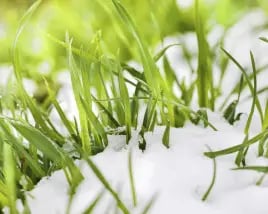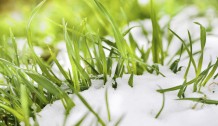Winter Lawn Care Tips

 Winter can often be unpredictable, putting your lawn through extreme conditions during its course. To counter winter weather, grass goes dormant at this time whether we have snow fall or not. However, this does not mean the end to lawn care. Making sure you have “put the lawn to bed” properly is crucial to ensuring a healthy, green spring.
Winter can often be unpredictable, putting your lawn through extreme conditions during its course. To counter winter weather, grass goes dormant at this time whether we have snow fall or not. However, this does not mean the end to lawn care. Making sure you have “put the lawn to bed” properly is crucial to ensuring a healthy, green spring.
How to Properly “Put Your Lawn to Bed”
Following a few simple tips can lead to a beautiful spring:
Fertilize and Aerate – Typically lawns in the North East are made of cool season grass blends making late fall or early winter one of the best time to fertilize. Before the first frost, you should give your lawn an aeration and fertilizer treatment to replace the nutrients that can be lost over the hot summer months. By aerating the compacted areas of the lawn you improve drainage and allow air to move freely into the root system. The fertilizer also moves deep into the root system and remains in the soil as the weather changes to feed the lawn all winter long resulting in healthy, green grass as spring rolls around.
Create a Mowing Strategy – As summer comes to an end, you should try to rest the lawn as much as possible. It is ideal to get in your last mow before the first snow cover of the season as it is essential to the lawn to prevent matting. Lower the mowing height by a notch or two (.05” – 1.0”) the last couple of times you mow as well. Excessively long grass can smother itself, cause disease and puts itself at risk for damage due to freezing and thawing. However, be sure to do this gradually as a sudden removal of the young grass growth can cause a shock and lead to damaged turf.
Clean It Up – It is extremely important not to leave debris, leaves or toys on your lawn during the winter. Objects such as these can smother and mat the lawn creating areas of disease, dead spots and stunted or thin areas of turf. Make it a common practice to do an occasional sweep of the lawn not only during the winter but throughout the whole year to prevent any damage or compaction.
Direct Traffic – While the grass is dormant and short, it becomes all too easy to forget that it shouldn’t be walked on. While typically grass is very resilient, during the winter months when it is not growing any breakage that occurs will not be addressed by the plant making it difficult to recover come spring. Try to keep your sidewalks clear of ice and snow so that you, guests and neighbors will not be tempted to cut through the lawn.